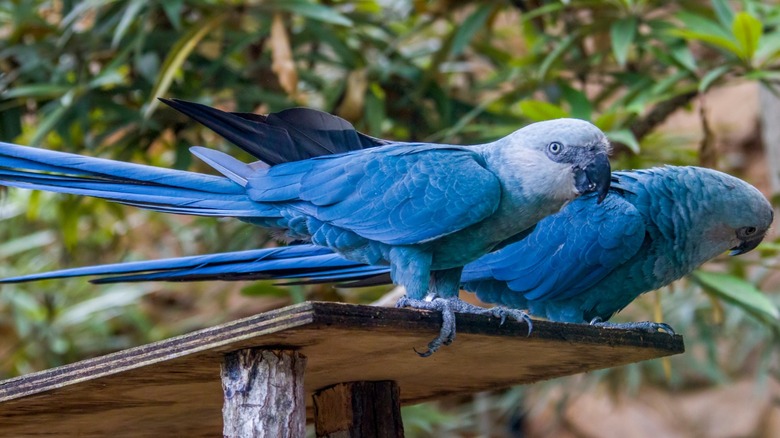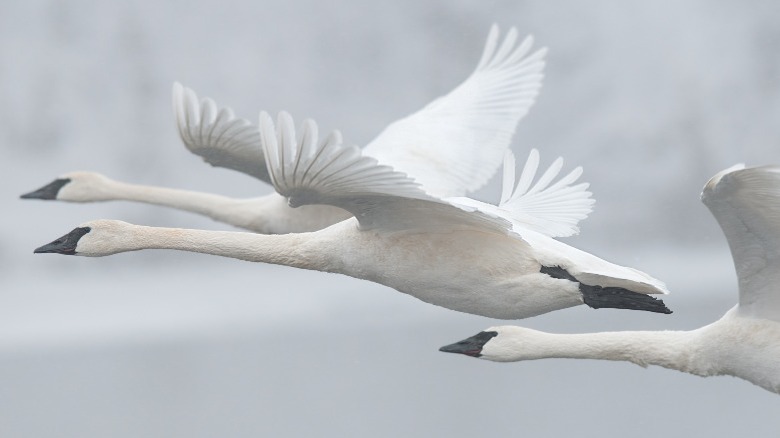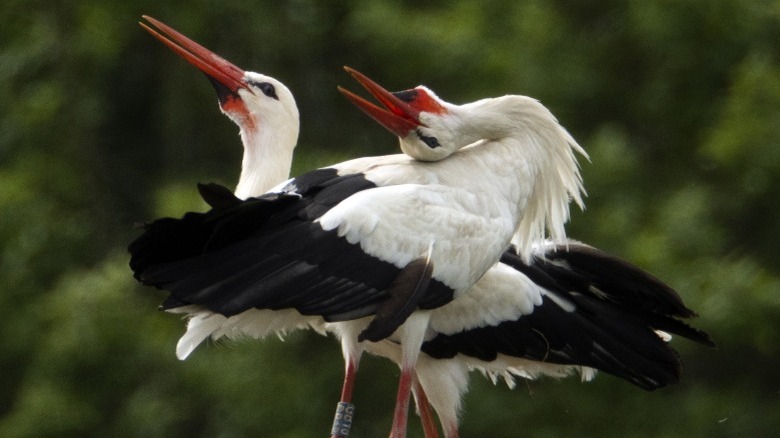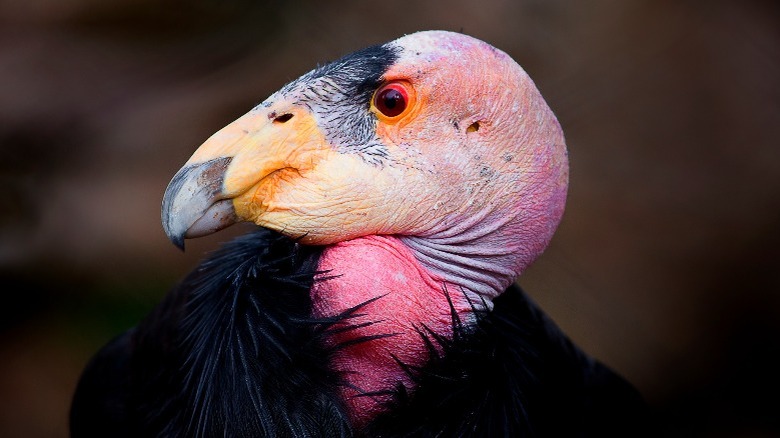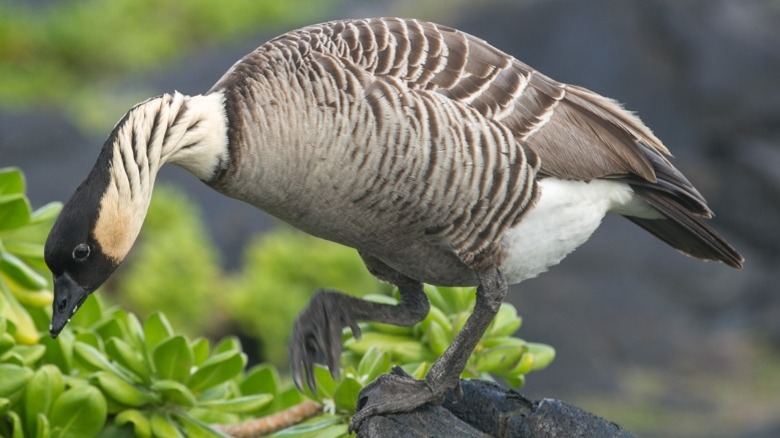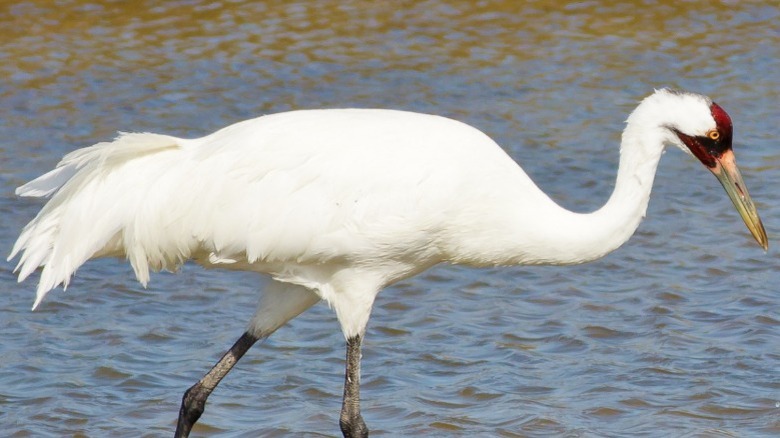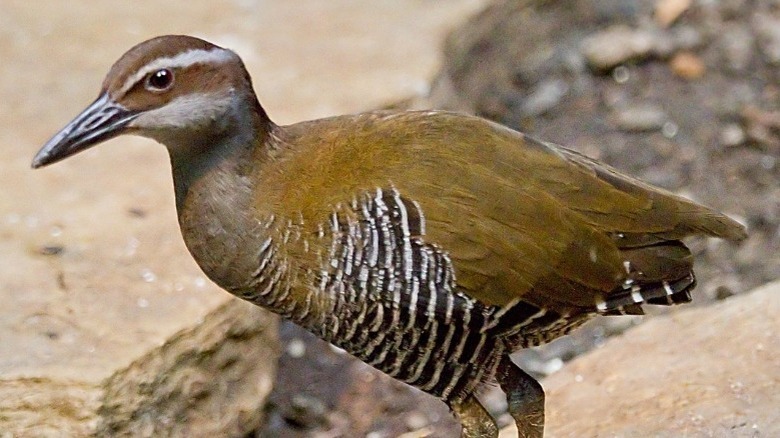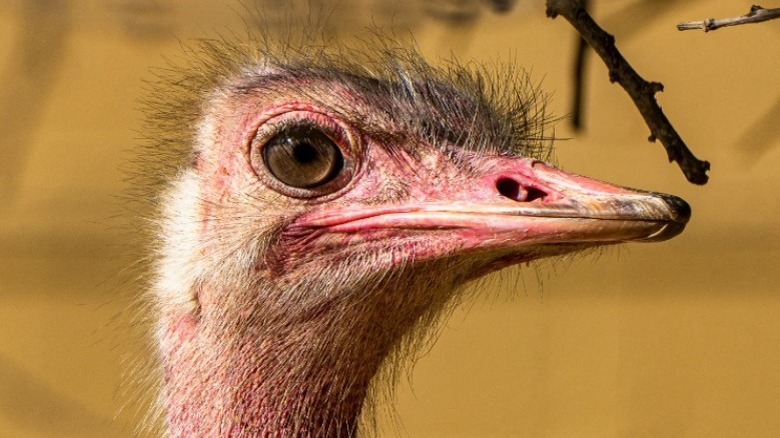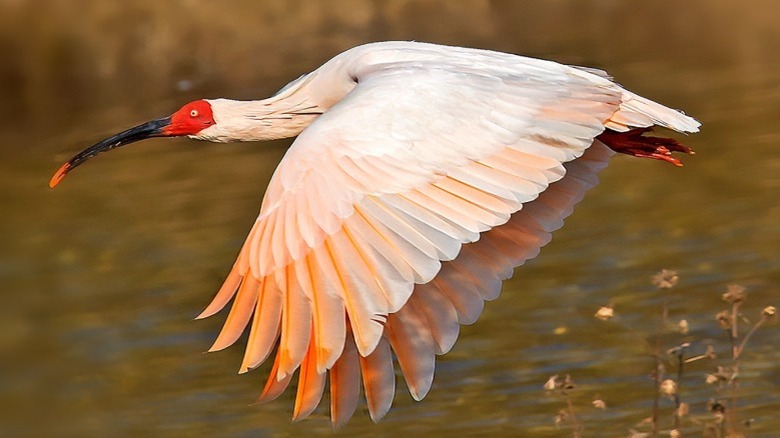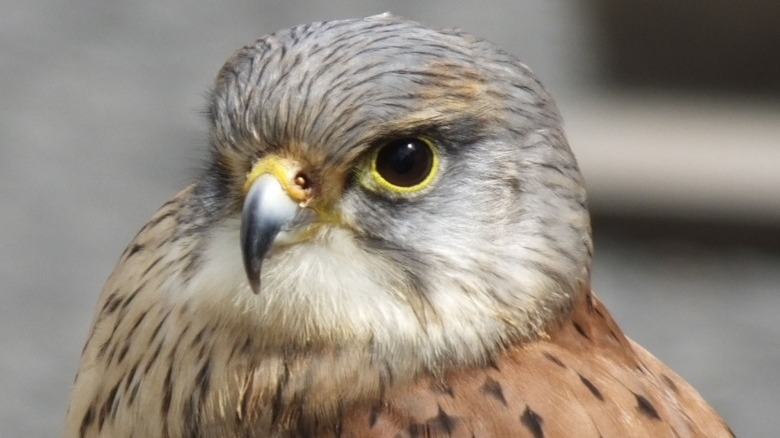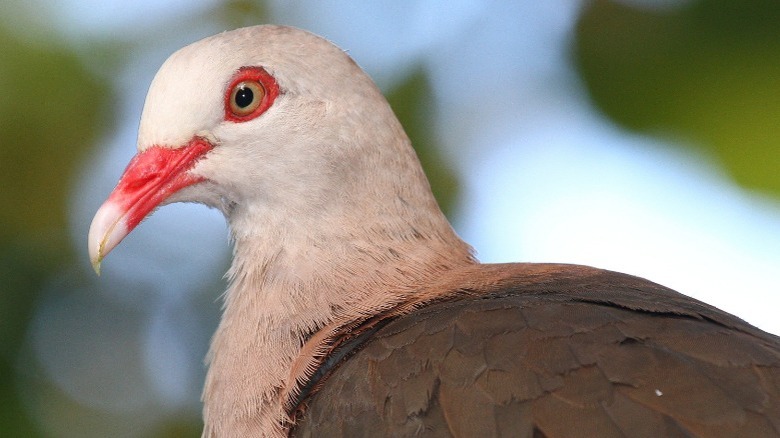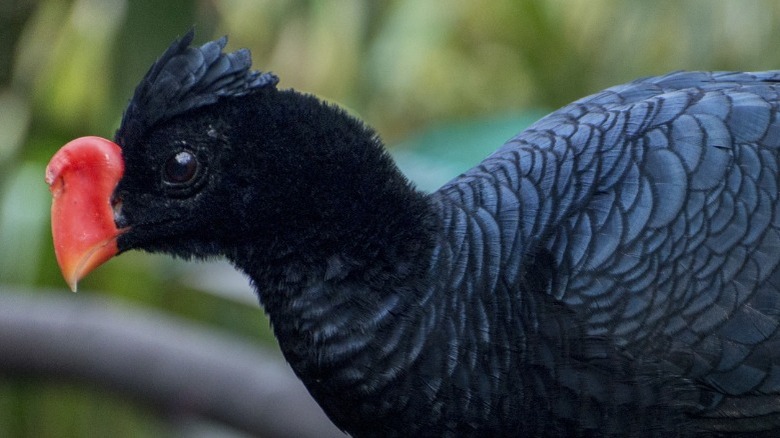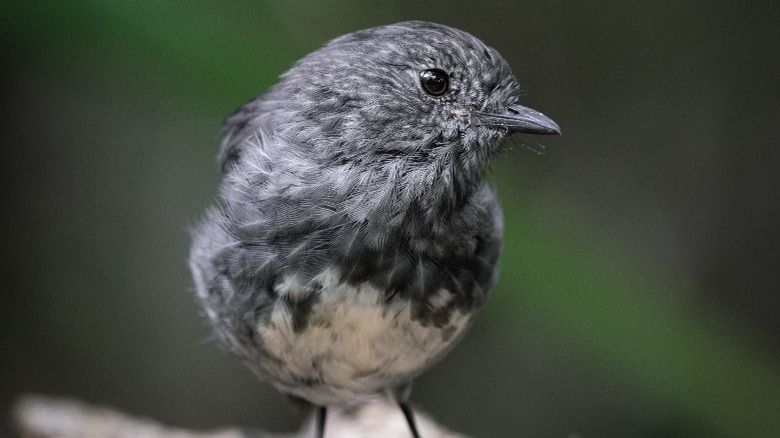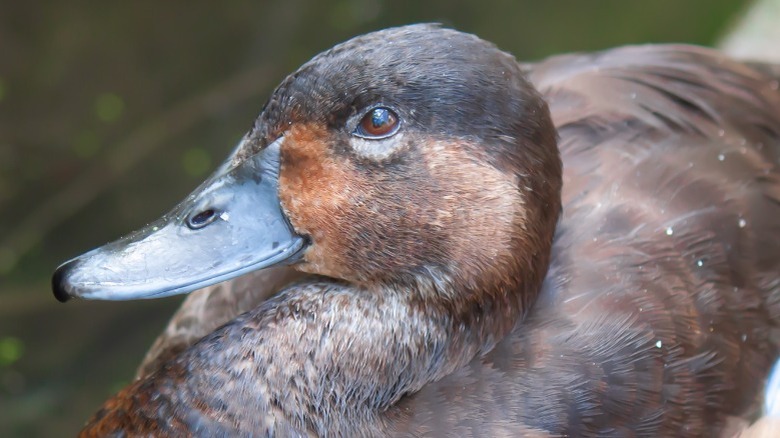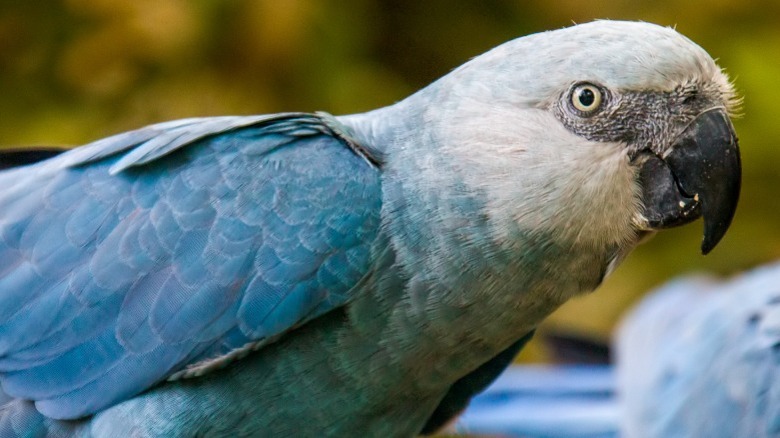Stunning Birds That Have Been Reintroduced To The Wild
Mankind has done a number on the world's birds. According to a 2021 study published in the Journal of Biogeography, humans have caused the extinction of at least 469 species of birds in the last 50,000 years. That's around 20% of all known birds! And, of these 469 birds, 182 have gone extinct in the last 500 years (per BirdLife International). To make matters worse, a 2022 study published in Annual Review of Environment and Resources found that 48% of the world's bird populations are likely declining. We are clearly causing their demise. So, shouldn't we be responsible for bringing them back?
While it's too late to save extinct species — like the iconic dodo of Mauritius, the once-abundant passenger pigeon of North America, or the dinosaur-like giant moa of New Zealand — we can sure fight to keep the birds we have left from meeting the same fate. Heroic conservation efforts are often required to pull a species back from the brink of doom. But sometimes these efforts succeed. From North Africa's massive red-necked ostrich to New Zealand's petite North Island robin, here are 14 stunning birds that have been successfully reintroduced to the wild.
Trumpeter swan
With its long, graceful neck and white plumage, the trumpeter swan definitely qualifies as stunning. According to Britannica, it has a length of 6 feet and up to a 10-foot wingspan, making it the world's largest swan. Trumpeter swans were once abundant in North America but were heavily hunted from the 1600s through the 1800s (per the Cornell Lab of Ornithology). Their feathers especially were prized as quills and décor in ladies' hats, and, per the National Wildlife Federation, their skins were also used for powder puffs. By 1933, fewer than 70 trumpeter swans were left (per California Wild Magazine).
Miraculously, aerial surveys of remote Alaska revealed a thriving population of trumpeter swans in the 1950s. Reintroduction efforts began shortly after the discovery. According to the National Wildlife Federation, eggs were carefully taken out from under the Alaskan birds — a harrowing task, considering swan parents are very defensive of their offspring — and flown back to the United States. Then came the challenge of rearing the cygnets using captive swans or even decoys so they didn't imprint on humans. Finally, the swans were released back to the wild.
Trumpeter swans have been successfully reintroduced to parts of the Midwest, Pacific Northwest, and Great Lakes area and have even started dispersing on their own. Today, Partners in Flight estimates a global breeding population of 63,000 swans — a far cry from the few isolated birds of the 1930s. While the species still faces challenges in its former range — like lead poisoning, illegal hunting, and habitat loss — the reintroduction is considered a classic conservation success story.
White stork
White storks — the very same ones said to deliver babies — have a storied history in the Old World. Once widespread throughout Europe, the 3-foot-tall black and white birds began vanishing from the region as industrialization expanded in the 1800s. Per National Geographic, destruction of wetland habitats, pesticide use, and manmade structures like powerlines all contributed to the species' decline.
According to a 2000 study published in Global Environment Research, white storks were last seen in Belgium in 1895, Switzerland in 1950, Sweden in 1955, and the Netherlands in 1991. Diligent conservation efforts have since restored storks to these areas, as well as Italy, France, and Spain (per National Geographic). But in England, the iconic birds were still a distant memory. As National Geographic notes, white storks had not lived in Britain for over 600 years, yet they remained a vital component of the region's history and folklore.
After two decades of restoring a wetland environment, the first 20 juvenile storks were reintroduced to West Sussex in 2016. They were temporarily housed in a six-acre pen along with four formerly wild birds who would help them learn how to survive before all 24 birds were set free in 2019. The project was a success. In 2020, the reintroduced white stork colony produced several chicks — the first wild storks to hatch in Britain since 1414.
California condor
Despite its common name, the immense California condor once ranged throughout North America and into parts of Mexico. With its 9-foot wingspan, height of over 4 feet, and weight of up to 24 pounds, it is considered the largest wild bird in North America (per the Cornell Lab of Ornithology). Still, the once-abundant species declined rapidly in the 19th century, and by 1987, only 27 of the giant vultures were left (per Smithsonian Magazine). According to the Cornell Lab of Ornithology, lead poisoning from bullet fragments in carrion was the main cause of the decline, but habitat loss, hunting, and strychnine-laced carcasses meant to poison coyotes also contributed.
Desperate to save the species, the U.S. Fish and Wildlife Service captured the last wild condors in 1987 and added them to a captive breeding program, as per Smithsonian Magazine. According to the California Department of Fish and Wildlife, the first two condors were reintroduced to California in 1992. More reintroductions soon followed, with birds being released in northern Arizona in 1996 and northern Mexico in 2002. In 2006, a pair of California condors nested inside an old redwood tree in Big Sur, becoming the first free-flying condors to nest in central California in 100 years.
Wild condors still fall victim to lead poisoning, and, per the Cornell Lab of Ornithology, many are treated each year to ensure their survival. Still, as of 2020, there are 504 California condors in the world, with 329 of these living in the wild. If this positive trend continues, the International Union for the Conservation of Nature will consider downlisting the species from Critically Endangered to Endangered in 2024. Per BirdLife International, the California condor was the first bird in history to come back from extinction in the wild.
Nene
Once upon a time, a flock of Canada geese apparently got lost and ended up in Hawaii (per Britannica). According to Hana Hou! Magazine, the descendants of this flock evolved into three species unique to the Hawaiian Islands: the nene nui, the giant Hawaiian goose, and the nene. Of these, only the nene (pronounced nay-nay) was able to fly. This gave the species a slight advantage over its cousins, which were quickly wiped out when Polynesians first settled on the islands.
As Richard Ellis notes in his book "No Turning Back," there were probably around 25,000 nenes on the islands when Captain James Cook arrived in 1778. But the birds had evolved without mammalian predators, so the cats, dogs, pigs, rats, and mongooses that humans brought with them — as well as habitat alteration and hunting — wreaked havoc on the unsuspecting species. By the 1940s, the nene could only be found on the Big Island.
Things got worse for the world's rarest goose when a tsunami hit Hilo in 1946, killing half of the remaining population (per Hana Hou! Magazine). By 1950, fewer than 36 nenes were left. Following an ambitious ten-year captive breeding program — in which three geese were even shipped to a waterfowl expert in England to be bred overseas — 35 British-hatched nenes were reintroduced to the Big Island and Maui in 1962. As of 2019, over 3,000 nenes are living in the wild, and the species was downlisted from Endangered to Threatened (per the Center for Biological Diversity).
Whooping crane
With a height of around 5 feet, the stately whooping crane is North America's tallest bird (per the Cornell Lab of Ornithology). In the 1800s, flocks of whooping cranes were a common sight in the prairie marshes of the northern United States and southern Canada — the U.S. Fish and Wildlife Service (USFWS) estimates that over 10,000 cranes once populated North America. But overhunting and the conversion of wetlands to farmland took the species down to only 21 birds in 1941.
In 1967, both the USFWS and the Canada Wildlife Service started captive breeding programs. According to the U.S. Geological Survey, raising cranes in captivity came with many challenges: Females had to be tricked into laying more eggs, handlers had to minimize contact with chicks to avoid imprinting, and using sandhill cranes as foster parents caused later issues with breeding. Ultralight aircraft even had to be employed to train the birds how and where to migrate. To this day, much of what we know about science-based wildlife reintroduction comes from saving the whooping crane.
While the first reintroduction attempt failed, later efforts have been successful at establishing three whooping crane populations in Florida, Louisiana, and Wisconsin (per the Cornell Lab of Ornithology). But challenges continue to plague the wild birds. Illegal shooting, extreme coastal weather, and contaminant spills from ships reduce population numbers each year. Habitats must also be constantly managed to ensure the cranes have adequate water and foraging sites. Still, per the North American Crane Working Group, around 684 whooping cranes were living in the wild in 2017.
Guam rail
In the early 1970s, Guam hosted a healthy population of 60,000 to 80,000 flightless birds known as Guam rails, as per Smithsonian's National Zoo and Conservation Biology Institute (SNZCBI). But, as BirdLife International notes, the once common species — known locally as the ko'ko' — began declining drastically in the late '70s and early '80s. The cause? An introduced reptile called the brown tree snake, which likely hitched a ride to the island on a military cargo ship after World War II.
Without any natural predators, the invasive snake turned Guam from paradise to hell. It decimated all of the island's birds — even driving three species to extinction — and altered the forests of Guam, which relied on the birds for seed dispersal. In the mid-'80s, biologists captured the remaining 17 Guam rails and started a captive breeding program to save the species (per SNZCBI). According to BirdLife International, rails were matched based on genetic diversity and personality until they had raised enough fluffy black chicks for a release.
But, until the snakes were eradicated, Guam was not safe for the birds. So, the first Guam rails were reintroduced to the nearby snake-free island of Rota in 1989 (per SNZCBI). In 2010, Guam rails were released on Cocos, another neighboring island. As of 2020, there were over 200 Guam rails living wild on Rota and 60 to 80 on Cocos. In 2019, the International Union for the Conservation of Nature downlisted the bird from Extinct in the Wild to Critically Endangered, making it the second bird in history to return from the dead.
North African ostrich
With males standing 9 feet tall and weighing around 330 pounds, the North African ostrich, also known as the red-necked ostrich, is the largest living bird on Earth (per the Jacksonville Zoo). According to the Sahara Conservation Fund, the North African ostrich is one of four subspecies of ostrich and once ranged across the entire Sahara and parts of the Sahel. But, over the last 50 years, hunting, habitat loss, and egg collection have taken their toll on the subspecies. It now survives in only a few fragmented populations (per the Marwell Zoo).
The Sahara Conservation Fund is working to get the North African ostrich reclassified as a distinct species, which will allow it to be listed as Critically Endangered by the International Union for the Conservation of Nature, affording it greater funding and protection. In the meantime, the fund is focusing on raising as many birds as possible through a captive breeding program.
According to the Marwell Zoo, small populations of North African ostriches have already been reintroduced to Morocco and Saudi Arabia. Birds from these populations were used to start an additional captive breeding program hosted by the Tunisian Direction Générale des Forêts and Marwell Zoo, and, in 2014, nine North African ostriches were reintroduced to Tunisia, where they had not been seen since 1887. As Marwell Zoo notes, the population has since grown to 65 birds, and some have successfully raised offspring in the wild.
Crested ibis
The striking crested ibis — with its pinkish-orange feathers and bright red face — is known in Japan as the Toki. According to the International Union for the Conservation of Nature (IUCN), the species was once found in far east Russia, Japan, China, and occasionally in North and South Korea. But by the 1930s, it was already rare. Per the IUCN, deforestation, the conversion of wetland areas to rice paddies, and the use of agrochemicals reduced the species' aquatic food supply, causing many birds to starve to death.
By 1981, per Nippon.com, there were only five crested ibises left in Japan. The birds were captured and brought into captivity, but, tragically, four died shortly after. With only one left, the species was considered as good as extinct. But, miraculously, seven wild crested ibises were discovered in China a few months later. They were captured, and a successful captive breeding program at the Beijing Zoo brought the species back from the brink of extinction. As of 2018, China boasts a wild population of around 1,000 crested ibises.
Japan received a pair of crested ibises from China in 1999 and began breeding the birds. In 2008, the first 10 ibises were reintroduced to Sado Island and, in 2016, 17 more were added to the population. According to a 2022 study published in Ibis, 457 crested ibises were living in the wild in Japan in 2021.
Mauritius kestrel
The Mauritius kestrel, a small falcon native to the island of Mauritius, was once known as the rarest bird in the world. According to the Zoological Society of London, widespread pesticide use and habitat loss pushed the bird to the remote fringes of the island in the 1950s. By 1974, there were just four Mauritius kestrels left in the wild. For everyone working to save the bird, it seemed like a lost cause.
But, according to The Guardian, renegade biologist Carl Jones refused to sit back and watch the Mauritius kestrel go extinct. To save the species, he took eggs from the wild birds' nests early in the breeding season. While he was incubating the first set in captivity, the wild birds laid a new clutch. Then he would add some of the captive chicks back to the nest. This meant that in every breeding cycle, two clutches were possible instead of just one. He also provided the wild birds with extra food, hung nest boxes to create more breeding opportunities, and killed any invasive mongooses he saw.
His efforts paid off. By 2000, there were 350 to 400 Mauritius kestrels in the wild (per the Zoological Society of London). As MongaBay notes, the International Union for the Conservation of Nature downlisted the species all the way from Critically Endangered to Vulnerable. Unfortunately, the population fell to around 250 birds in 2021, but efforts are in progress to reverse this trend. The Mauritius kestrel's remarkable comeback is one of the most successful bird recoveries in conservation history.
Pink pigeon
Another native of Mauritius, the pink pigeon, has also struggled with human colonization of the island. Like its extinct cousin the dodo, the species was decimated by introduced predators such as cats and rats, who found it an easy target (per The Conversation). The clearing of the island's forests also took away most of its habitat. By the 1980s, only around 10 pink pigeons were left in the wild.
As The Conversation notes, biologists had already taken 12 pink pigeons into captivity and started a breeding program. Per the Zoological Society of London, conservationists worked to restore the species' habitat, remove invasive predators, and provide supplemental food to the remaining wild birds. Then, from the 1990s through the early 2000s, birds were released back into the wild. As of 2022, around 480 pink pigeons are living on Mauritius. The reintroduction is considered a success, and the International Union for the Conservation of Nature has changed the species' status from Critically Endangered to Vulnerable.
But pink pigeons are not out of the woods yet. A 2022 study published in Conservation Biology has revealed that low genetic diversity and inbreeding have caused harmful mutations to accumulate in the pink pigeons' DNA. Left unchecked, the species will slowly lose the ability to reproduce. A plan is currently in place to add genetic diversity back to the Mauritius population by way of breeding pink pigeons in zoos and releasing their offspring. This situation proves that conservation work must continue long after a recovered population appears to be stable.
Alagoas curassow
The Alagoas curassow, a tropical gamebird native to Brazil, fell victim to hunting and agriculture as its forest habitat was cleared to make way for sugarcane plantations (per MongaBay). By the 1980s, only a few birds remained in the wild, and the International Union for the Conservation of Nature declared the species Extinct in the Wild in 1994.
According to MongaBay, businessman and bird breeder Pedro Nardelli traveled to the state of Alagoas and searched for the last remaining members of the species in 1979. He was able to locate five birds, which he took to his facility to breed. Two years later, the forest he rescued the birds from was felled — had he not captured them, the species would already be extinct. Over the next few years, Nardelli and his team worked to increase genetic diversity through selective breeding while a section of habitat was set aside for the birds. There are now around 100 Alagoas curassows in captivity.
In 2019, three mated pairs were reintroduced to a 2,400-acre section of forest in Brazil — returning to the wild three decades after they had become extinct. The release marks the first time a bird has returned from extinction in Latin America. The curassows are being closely monitored via GPS to ensure that they can find food and avoid predators, and the forest is regularly patrolled for poachers. If the six birds do well, more will be released in 2024.
North Island robin
The North Island robin — locally called the toutouwai — is a small songbird native to the North Island of New Zealand and a few of its smaller offshore islands. According to a 2002 study published in Conservation Biology, the species was hit hard by introduced predators and habitat loss and became locally extinct across much of its original range. By the early 1990s, the populations were small and isolated, and the birds were gone from many islands altogether.
Per the study, conservationists first worked to create areas of healthy habitat and remove invasive species such as rats, focusing their efforts on the island of Tiritiri Matangi. Then, in 1992 and 1993, a total of 58 robins were reintroduced to the island, which had not hosted the species for years. The birds successfully bred and increased their population in subsequent years, and the reintroduction was pronounced a success.
Inspired by the effort, other groups are also working to reintroduce the North Island robin to its former range. According to Massey University, following 20 years of work restoring habitat and removing predators, 40 North Island robins were captured in forests near Whanganui and reintroduced to Turitea Reserve in 2021. As of 2022, per Stuff, rats are proving to be a continued problem for the newly released birds, and efforts to eradicate the predators are in progress.
Madagascar pochard
The Madagascar pochard, a diving duck from Madagascar, used to be common across the island's wetlands. But, according to Wildfowl and Wetlands Trust (WWT), deforestation, overfishing, and pollution took a toll on the wetlands — and in turn, the duck. As the International Union for the Conservation of Nature notes, the species was last seen in 1991 and was listed as Critically Endangered shortly thereafter. Many thought it was likely extinct.
Miraculously, according to Smithsonian Magazine, 25 pochards were rediscovered on a remote lake in 2006. Biologists collected three clutches of eggs from the wild ducks and used them to start a captive breeding program. By 2018, they had raised 114 Madagascar pochards. However, finding a good place to reintroduce them proved challenging as most of Madagascar's wetlands are in shambles. The lake the pochards were rediscovered on was too cold and deep for the ducks, and, as a result, few ducklings were able to feed, and most perished. To make matters worse, more suitable lakes were overrun by introduced fish like tilapia and carp, which disturbed the water and took food from the ducks.
Out of options, conservationists began an ambitious project to restore Lake Sofia, involving local communities and farmers. In 2018, 21 Madagascar pochards were released from their floating aviaries on the lake and successfully returned to the wild. According to the WWT, the reintroduced ducks successfully hatched 12 wild ducklings in 2019.
Spix's macaw
The Spix's macaw — with its two-toned blue plumage and gray head — is truly stunning. Unfortunately, per the Association for the Conservation of Threatened Parrots (ACTP), it's also the rarest parrot in the world. According to Science, most of the macaws' native Brazilian caatinga, or "white forest," habitat was cleared for agriculture. And, per the Pairi Daiza Foundation, overgrazing by livestock also made it impossible for the caraibeira trees it depends on for survival to grow. To make matters worse, poaching for the pet trade, the construction of a dam, and introduced Africanized honeybees further jeopardized the species (per the IUCN).
According to Science, only three Spix's macaws lived in Brazil in 1987, and by 2000, the last wild parrot was gone. The IUCN officially declared the species Extinct in the Wild in 2019. Desperate, several conservation groups partnered with the Brazilian government to save the species. They rounded up every last Spix's macaw in captivity — including zoo animals and pets — coming up with around 71 birds by 2010. Then, they used artificial insemination to make ideal genetic matches and breed enough parrots to justify a release. As of 2022, there are 160 Spix's macaws in the program (per ACTP). (If any of this sounds familiar, the 2011 animated film "Rio" was based on the Spix's macaw's plight.)
Following years of preparing habitat for the birds, eight Spix's macaws were released in summer 2022 alongside eight wild-caught Illiger's macaws, which would hopefully show the captive-bred birds the ropes (per Science). If the birds do well (which is the case so far, per The Guardian), 12 more birds will be released by the end of the year (per CBC). The reintroduction marks the first time in two decades that Spix's macaws have flown free in Brazil. Should they survive, the species will return from extinction.
